Church Decorations at Fashionable Weddings - 1902
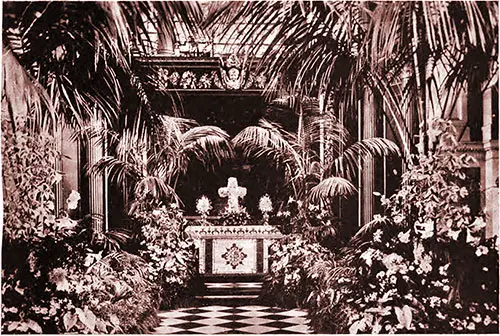
The Chancel and Altar, St. George's, Hanover Square, as Decorated for the Wedding of Lady Clodagh Beresford and the Hon. Claud Anson. Lady's Realm, June 1902. GGA Image ID # 1603da0d8b
The idea of turning fashionable London churches into a veritable forest of palms and flowers for lavish Society weddings is quite an innovation. While ten years ago, church decorations on such a scale were never thought of. It seems probable that today these decorations have reached their limit due to objections on the clergy's part.
The Vicar of St. Paul's, Knightsbridge, has a strong objection to his church being turned into a colossal conservatory. Similarly, at St. Peter's, Eaton Square, the professional florist cannot carry out the decoration even in cases where a large contract has been placed with him.
He simply delivers the palms, flowering plants, and cut flowers, leaving the actual decoration scheme to the church officials.
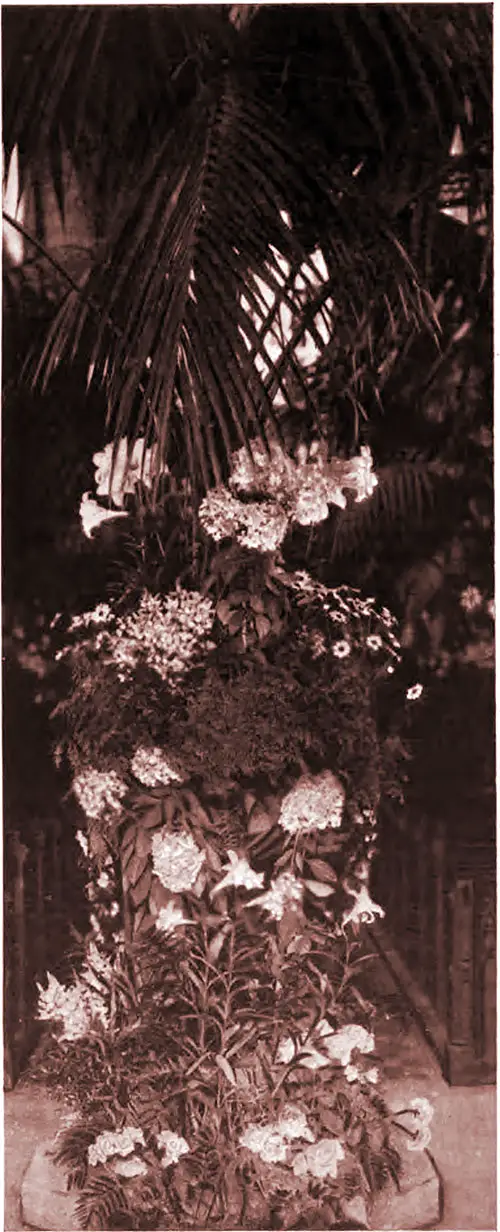
The Font, St. Margaret's, Westminster, as Decorated at a Recent Fashionable Wedding. Lady's Realm, June 1902. GGA Image ID # 1604021d0f
In some cases, the fact seems to be almost forgotten that a wedding is not a flower show and the church a sacred building.
In the case of a wedding of the first importance, like that of Lord Stavordale and Lady Helen Stewart, the floral decorations, both in the church and at the bride's house, not to mention such details as novelties in bridesmaids' bouquets, etc., involve an amount of artistic planning and a systematic industry which yields an astonishing quantity of exciting facts and information.
Take what used to be the most fashionable London church for weddings — St. George's, Hanover Square.
Ordinarily, the florist gets about a month's notice for a large function.
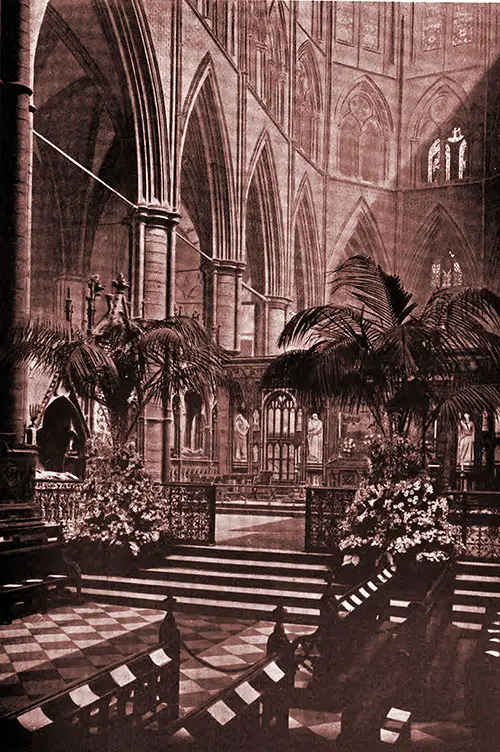
The Sacrarium, Westminster Abbey, as Decorated for the Wedding of the Earl of Crewe and Lady Peggy Primrose. Lady's Realm, June 1902. GGA Image ID # 16040d3c7f
Suppose there are three or four weddings at St. George's, Hanover Square, on one day; sometimes, in such cases, the artist will bring about a curious kind of cooperation, ascertaining the requirements and tastes of all the parties, and then to arrange the display as to satisfy each.
Then, after the first wedding, the decorations are not removed but left for the others. In this way, each wedding-party benefits from the most elaborate and beautiful floral decorations in the church at a significantly reduced cost. The expense is borne not by one person, but by three or four.
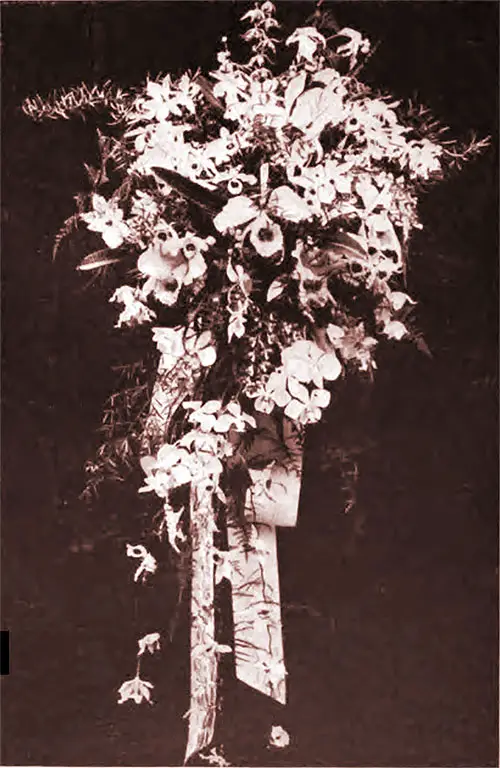
A Coronation Bridal Bouquet. Lady's Realm, June 1902. GGA Image ID # 16042312fa
It is generally known that many of the fashionable London "wedding" churches have their appointed florist. Thus St. Margaret's, Westminster, is in the hands of Messrs. Wills & Segar. At the same time, Holy Trinity, Sloane Street, is done exclusively by another firm.
The floral decorations of St. George's, Hanover Square, are mainly by Mr. Bellgrove, whose nurseries are at 81, Fulham Palace Road, Hammersmith.
On receiving the order to decorate a church, the artist at once prepares designs that embrace the various flowers available at that particular season. When these designs are completed—and of course, many things have to be taken into consideration besides the amount to be expended, such as the size of the church, the flowers available, tastes expressed for a particular flower or foliage—they are submitted for the inspection of the bride's mother.
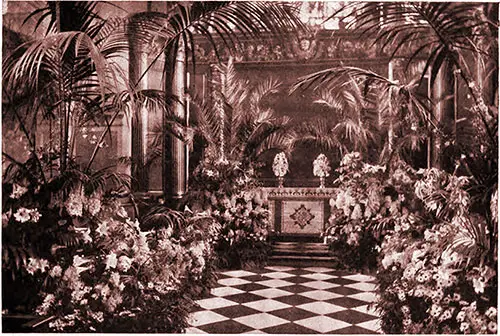
St. George's, Hanover Square, as Decorated for the Wedding of the Hon. Henry Portman and Countess of Portarlington. Lady's Realm, June 1902. GGA Image ID # 16045a7a03
Sometimes this lady will want all palms, or she may want no palms at all. Another will prefer cut flowers to plants. Yet another will like a discreet mixture of palms and foliage plants — dracaenas, crotons, and variegated maples.
By the way, perhaps the flower that enters most prominently into church decoration for fashionable weddings is the gorgeous Lilium harissa, of which not scores, but hundreds of blooms would be used. White heather is also extremely popular, while in autumn, there are available hydrangea paniculate and chrysanthemums.
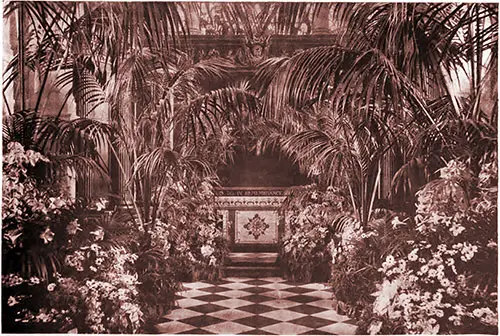
St. George's, Hanover Square, as Decorated for the Wedding of the Hon. Walter Fitz-Uryan Rice and Lady Margaret Villiers. Lady's Realm, June 1902. GGA Image ID # 16048acce3
From September to January, the floral church artist works predominantly on white chrysanthemums, marguerites, lilies of the valley, and cyclamen.
The foliage plants are practically the same all the year-round, except for caladium, which is usually only available from May to October.
In February, the artist also has the deutzia to work with — a beautiful little white flower. In the winter months, the grower also sends him the opulent lily known as Lancifolium.
A little later, the "material" available includes white lilac.
You will presently realize what an essential and intricate business is decorating fashionable churches on a grand scale for important Society weddings. Three years ago, the artist could only get lilies of the valley from December to August.
Still, now he gets them all the year-round, thanks to the retarding of the bulbs through freezing. March brings the white hyacinth and white azalea, while in the summer months of June and July, of course, there are enormous quantities of seasonable blooms grown in the open air.
It may be asked, "Where are all these exquisite snow-white bridal flowers obtained in season and out of season?" The fact is, the floral church artist grows significant quantities himself. Still, in the nature of things, he is mainly dependent upon the grower.
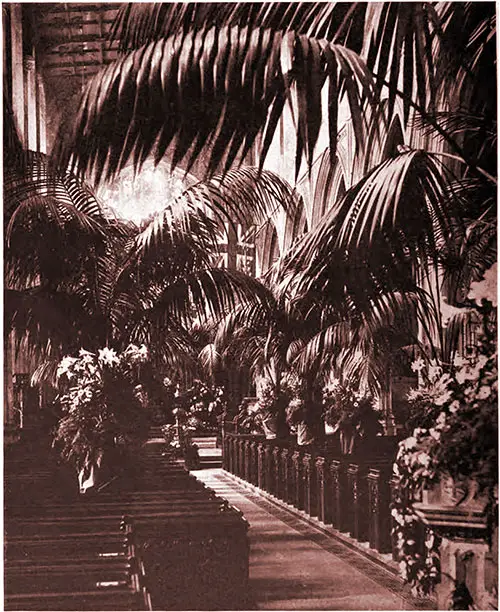
An Avenue of Palms, St. Margaret's, Westminster, as Decorated for a Recent Wedding. Lady's Realm, June 1902. GGA Image ID # 16049aa678
For example, he turns to the famous orchid grower, Sander, of St. Albans, for gorgeous blooms, and to Rochford, of Cheshunt, for the new pure white bridal orchid, which is now quite the "correct thing" for bridal bouquets in the Coronation season.
Palms play an essential part in the wedding decoration of churches. The artist is obliged to keep a perfect forest of this most graceful of plants. By the way, many of them are grown here in England from seed, although the process is hugely uncertain.
It will be news to most people that the most immense palms used for decorative purposes — such as those over twenty feet high —may be centenarians in point of age.
The two varieties mostly used for wedding-decoration in churches are the palms known as the Kentia and the Cocos flexuosa. Though of graceful foliage, the bamboo is not much used, growers here import the seeds of the palms from the tropics.
Though the seed is cheap enough, twenty thousand may be sown and yet not produce five hundred plants.
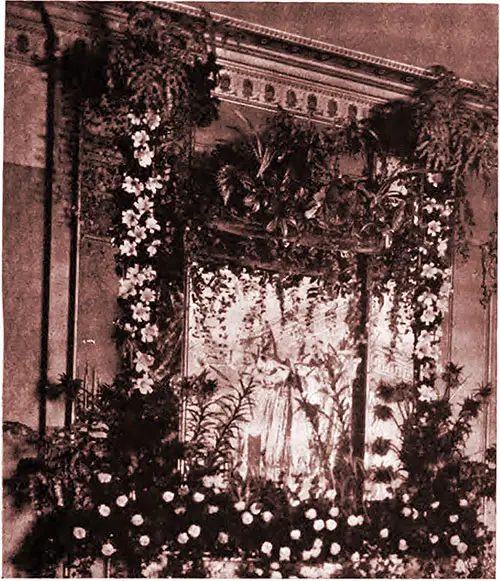
A Mantelpiece as Decorated for a Wedding Reception. Lady's Realm, June 1902. GGA Image ID # 1604fce4cd
The bride's mother, harassed with cares of all kinds, from the monstrous five-tier cake (now decorated with the most exquisite of natural flowers) right down to the honeymoon's railway tickets, is not allowed to neglect the vital matter of church decoration.
There is generally more than one meeting in the church itself between the floral contractor and the bride's people, to go over the ground, as it were, in a "preliminary canter."
The decorative artist then gives his ideas and submits original designs, of which he must have a significant number. In case this demonstration is not enough, there is a kind of dress rehearsal with all the interested parties, who are invited to the church to see another wedding— to criticize it, give their opinions generally, and receive impressions.
On this occasion, they get the full benefit of other people's experiences. They can see for themselves not only the identical church gorgeously decorated with palms and flowers but also witness the actual ceremony.
The artist-contractor, who devotes himself mostly to orders for fashionable Society weddings, must be something of a diplomatist and a man of consummate tact. If he is not known to the church officials and clergy, he has a horrible time.
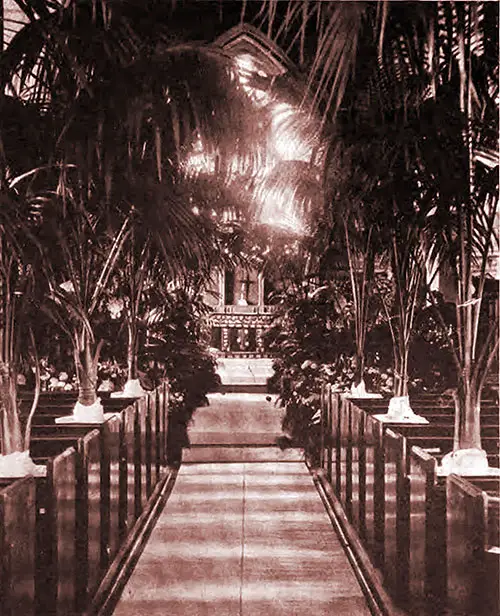
A Decoration of Tree Palms and Laburnum. Lady's Realm, June 1902. GGA Image ID # 16050781ff
Naturally, the rector has a good deal to say in the matter. He is most emphatic that neither the choirboy nor the clergy is hidden, even by the most gorgeous flowers.
Another condition imposed is that the marriage ceremony itself must be visible from all parts of the church.
No matter how long the preliminaries may take, no active work is allowed in the church until the very morning of the wedding. Then it is absolutely stipulated that no service must be interfered with. With his men, the florist, his palms, his cut flowers, and his wilderness of blossoming plants, must clear out discreetly at the right moment.
As a rule, the florist has only four hours in which to decorate the church. However, in very exceptional circumstances, he is granted an extension of time, as was the case with Miss Evelyn Millard's wedding at St. George's, Hanover Square, when the floral decorations were perhaps the richest and gorgeous on record—a wilderness of Kentia and Cocos flexuosa palms and fern masses, lilies and caladiums, arches of roses and banks of roses and stephanotis.
But it may be taken for granted that the floral decorations for the wedding were more elaborate than the Rector of St. George's would have sanctioned had he been in town.
From all this, you will gather that there has to be a good deal of system about the work. Indeed, it is quite astonishing what a dozen expert men can do in a church, with each palm-tub carefully labeled "Southside of the chancel," and so on, every floral and foliage item being dexterously fed by the men to their foremen, who place them in position.
Nothing unsightly must be left to offend the eye. Pots and tubs are entirely hidden with flowers, foliage, and flowering plants— borders of grass known as isolepis rounding off the corners.
Very early on the morning of the wedding, the palms, plants, and flowers are packed carefully into special vans, which may have to be specially heated with footwarmers, charcoal braziers, and other means of preserving the life of the delicate hot-house growths, which may run the risk of being exposed to a toxic and icy atmosphere.
The men's first thing on arriving at the church is to change their boots and put on felt slippers. In moving about swiftly, they may also move quietly and discreetly in the sacred edifice.
The next step is carefully to cover the whole of the aisle with old red baize, to prevent the scratching of the paving-tiles or wood blocks. The large palms are first brought in — the Kentias perhaps eighteen feet high.
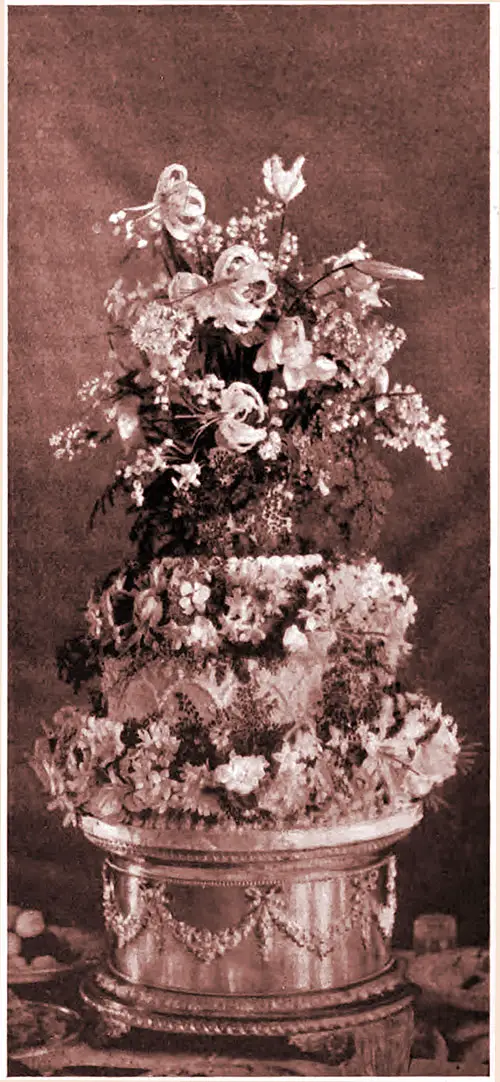
Fashions in Real Flowers in Wedding Cakes. Lady's Realm, June 1902. GGA Image ID # 1605096eff
The Cocos flexnosa right up to lofty waving specimens of thirty feet. By the way, these large and valuable Kentia palms may be worth from seventy-five to one hundred guineas apiece and are handled with infinite care by six men —four at the tub and two at the "head."
The first part of the actual wedding ceremony taking place at the chancel, and the second at the altar, these are naturally the spots where the decorative floral artist expends most of his ingenuity, at the same time bearing in mind the warning of the rector not to hide the clergy nor the principal actors in the interesting scene.
The altar's floral decorations usually take the form of a cross worked in hyacinths or lilies of the valley. Then there may be a few flat-backed altar bouquets.
As the men bring in the flowering plants and foliage plants, they stacked down the aisle and supplied swiftly and noiselessly to the head men, who have known long beforehand exactly where each pot or tub is to go.
Like a captain on the bridge of his ship, the contractor himself superintends the whole of the decoration, with his charts in his hand and his keen eye ever alert for a charming effect.
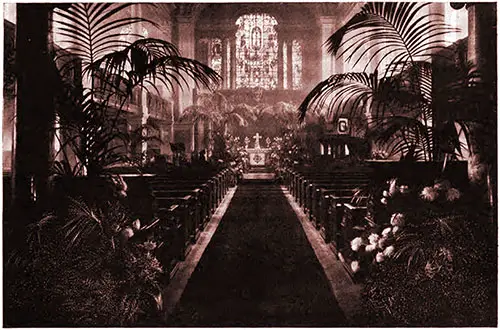
St. George's, Hanover Square, as Decorated for the Wedding of Sir Meyrick Burrell and Miss Winans. Lady's Realm, June 1902. GGA Image ID # 1605415b35
Flower fashions in weddings change even as dresses do. As it has been found that the bridal bouquet may be a serious bore and inconvenience to a girl much worried by the arranging of a gorgeous train in the narrow confines of a smart coupé, it is now the custom to hand the bride and bridesmaids their bouquets at the church.
This arrangement also ensures that the flowers are deliciously fresh and not drooping after perhaps half an hour's enclosure in a warm hand.
Quite the latest thing in bridesmaids' bouquets is, oddly enough, not a bouquet at all. Still, a white enameled cane bent at the top in the form of a shepherd's crook, and exquisitely decorated and worked with flowers, with perhaps small bouquets with ribbons pendant from the head.
These sticks are specially made in London. When the bridesmaids carry ordinary bouquets, they are arranged to match any color they may be wearing in their hat or sash, possibly pink carnations or violets.
The floral shepherd's crook, however, is quite the smartest thing. At St. George's, Hanover Square, these pretty novelties figured at two weddings one after the other.
The floral crook has even supplanted another novelty in bridesmaids' bouquets—prayer books. Their covers entirely worked in hyacinth or lily of the valley.
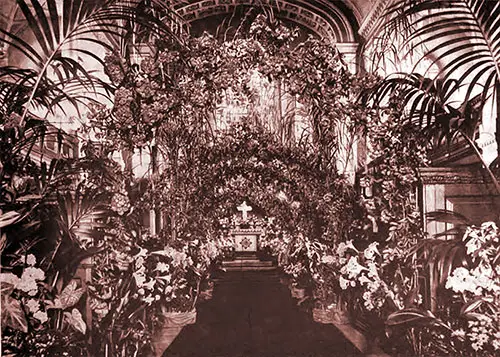
St. George's, Hanover Square, as Decorated for the Wedding of Miss Evelyn Millard, With Arches of Crimson Rambler and Lilies. Lady's Realm, June 1902. GGA Image ID # 1605707265
The latest fashion in the bride's bouquets for the Coronation season is a magnificent drooping arrangement of snow-white, star-shaped orchids of the piscatorial variety.
Bows of white corded silk ribbon enclose from twelve to twenty dozen of these lovely blooms. The Coronation bridal bouquet on these lines has entirely eclipsed the old bouquet of mixed flowers, chrysanthemums, and roses, stephanotis, bouvardia, tuberose, gardenia, and lilies of the valley.
By the way, it is interesting to learn from the floral artist that no bridal bouquet can be made up until accurate information is forthcoming as to the size of the bride!
There appears to be a regular scale of proportion in the matter of size between the bride and her bouquet.
After a few hours of almost noiseless labor, we will suppose that the church is converted into a perfect bower of graceful foliage, waving palms, and exquisite snow-white flowers and that the floral artist himself is lying in wait for the bride and bridesmaids with their respective bouquets.
Well, then comes the matter of floral favors for the guests, which are usually distributed by the bridesmaids while the bride and bridegroom are in the vestry. In this way, the smartest thing is one single white orchid with a loop of very narrow white silk ribbon attached. Another favorite flower as a guest favor is the myrtle-bloom.
The orange blossom as a wedding-favor is very expensive. Still, at a recent wedding, no fewer than five hundred real orange-blossom favors were specially procured from the South of France.
The actual wedding-ceremony takes about half an hour; and when the bride and bridegroom come out from the vestry, and the organ strikes up the wedding march, the latest pretty fashion is to have baskets of white rose-petals, which two of the bridesmaids sprinkle in front of the happy couple all down the aisle.
The bride and bridegroom may also be pelted with these petals—a much-welcomed innovation on the ancient savage custom of hurling blinding rice or stupid old satin shoes or confetti.
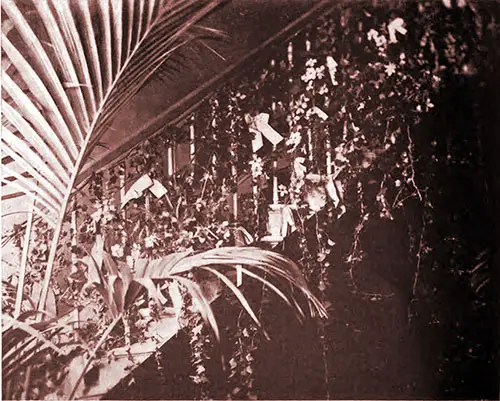
The Decoration of a Staircase for a Wedding Reception. Lady's Realm, June 1902. GGA Image ID # 160599cc2b
To descend to prosaic details, about four quarts of white rose-petals are supplied. When the beautiful niphetos is a costly bloom in the off-season, a supply of this "ammunition" is an expensive matter.
On the other hand, in the summer months, this lovely white rose's petals are to be had in any quantity, for the picking up, in the artist's own houses.
Even the wedding cake is decorated with real flowers now; however, these must be small flowers, such as bouvardia, lily of the valley, Cape jasmine, white carnations, and orange-blossom.
These decorations are made in wire rings to fit around the different tiers of the cake. However, the very latest thing is a kind of bower of lovely flowers forming a double-crossed arch over the top of the cake, with a beautiful wedding-bell constructed entirely of spotless flowers suspended beneath the arch.
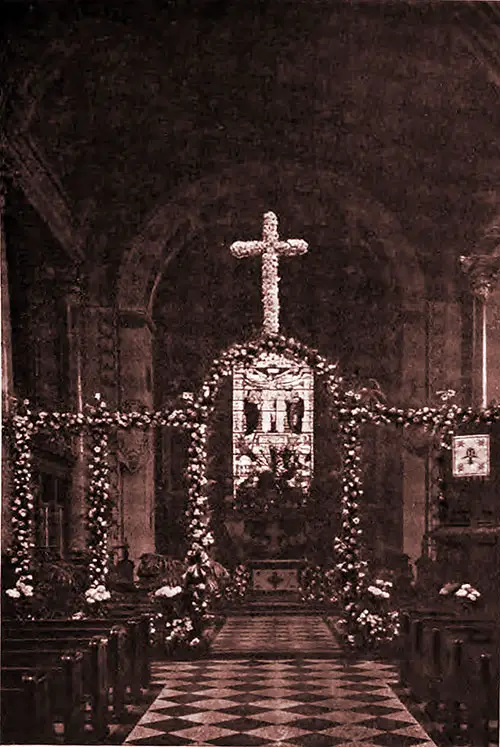
St. Botolph's, Bishopsgate, as Decorated for a Recent Wedding. Lady's Realm, June 1902. GGA Image ID # 16060c6a0e
All around a cake so decorated would hang bunches of pretty little silver bells, attached by white silk ribbons, and engraved with the bride and bridegroom's initials. These silver bells would be distributed among the guests when the cake came to be cut up.
The last part of the floral artist's work is decorating the bride's mother's house for the reception. Here a large amount of money is spent turning the balusters of staircases into perfect walls of foliage and flowers intermixed with masses of white silk and satin ribbon.
Even mantelpieces and fireplaces are florally decorated for these receptions. When a great and noble family adds their conservatories' contents to those of the artist-contractor, the result is almost overpowering.
Sometimes the bride and bridegroom will stand to congratulate their friends beneath a colossal flower-bell suspended from the ceiling.
W. G. Fitzgerald, "Church Decorations at Fashonable Weddings," in Lady's Realm: An Illustrated Monthly Magazine, London: Hutcinson and Company, Vol. XII, No. 2, June 1902, pp. 173-183.
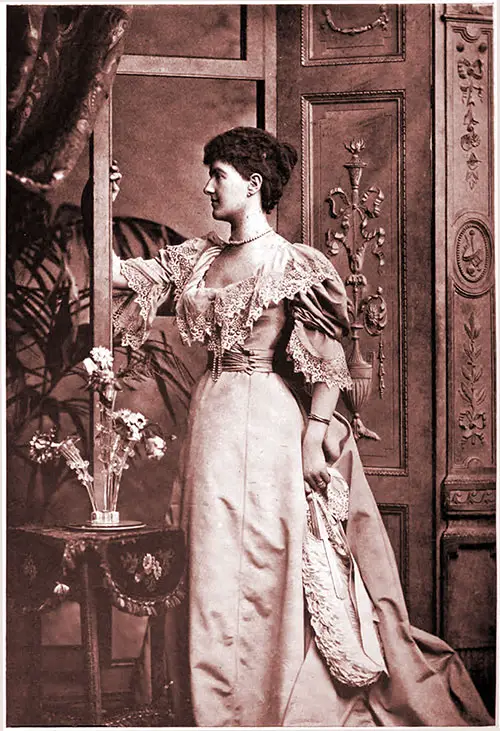
The Duchess of Montrose. Photo by Lafayette, Dublin. Lady's Realm, June 1902. GGA Image ID # 16063afed1
Note: We have edited this text to correct grammatical errors and improve word choice to clarify the article for today’s readers. Changes made are typically minor, and we often left passive text “as is.” Those who need to quote the article directly should verify any changes by reviewing the original material.
